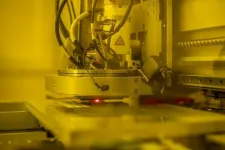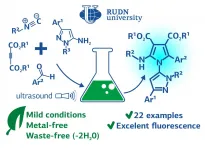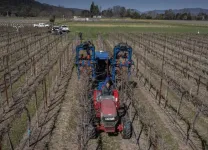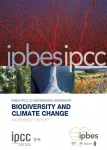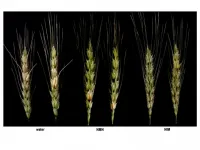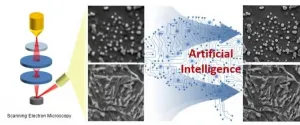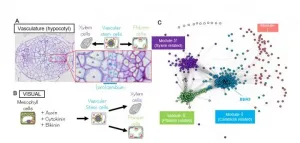Botany: Scent of death attracts coffin flies to pipevine flowers
2021-06-10
(Press-News.org) Plants use numerous mechanisms for their pollination. Now botanists have discovered a particularly sophisticated system among pipevines that is based purely on deception.
The flowers of the Greek plant Aristolochia microstoma emit a foul, musty scent that seems to mimic the smell of decaying insects. The fly pollinators from the genus Megaselia likely get attracted to this odor while searching for arthropod corpses to potentially mate over and lay their eggs. Then, when entering the tube of an Aristolochia flower, the flies are guided by downward-pointing hairs into a small chamber, which holds the female and male floral organs. Trapped inside, they deposit pollen they carry onto the stigma, before the stamens ripen and release pollen on the body of the flies. When the hairs that block the entrance to the chamber wither, the pollinators can escape, and a new cycle can begin.
"Here we show that the flowers of A. microstoma emit a highly unusual mix of volatiles that includes alkylpyrazines, which are otherwise rarely produced by flowering plants. Our data suggest that this is the only plant species known so far to deceive pollinators attracted to the smell of dead and rotting arthropods, rather than vertebrate carrion," says corresponding author Prof Stefan Dötterl, the head of the plant ecology group and the Botanical Garden at the Paris-Lodron University of Salzburg, Austria.
Between 4-6% of flowering plants are deceptive: they use odor, color, and / or tactile signals to advertise a reward to pollinators, such as nectar, pollen, or mating and breeding sites, but do not actually give this reward. The deception works because pollinators are poor at distinguishing between the reward and the mimic. Deceptive pollination is typical of many orchids, but has also independently evolved many times in other plants, including the genus Aristolochia.
"Aristolochia contains over 550 species spread around the world, especially in tropical and subtropical areas. Aristolochia species are mostly woody vines and herbaceous perennial plants with spectacular, complex flowers that temporarily imprison their visitors for pollination purposes", explains Prof Christoph Neinhuis, co-author of the study, who cultivates one of the largest Aristolochia collection worldwide at the Botanical Garden of TU Dresden.
"Many Aristolochia are known to attract flies with floral scents, for example mimicking the smell of carrion or feces of mammals, decaying plants, or fungi," says Thomas Rupp, first author of the study. "But our curiosity was piqued by A. microstoma, a small herb known only from Greece: unlike other Aristolochia with their colorful, showy flowers, A. microstoma has inconspicuous brownish flowers that lie horizontally - close to the ground or partly buried, among leaf litter or between rocks."
"A. microstoma flowers emit a simple but highly unusual mix of scents that includes 2,5-dimethylpyrazine, a molecule that does not occur in vertebrate carcasses or feces, but in dead beetles. The unpleasant, carrion-like scent can be noticed by people even at a short distance," concludes botanist Prof. Stefan Wanke from TU Dresden.
INFORMATION:
Original publication:
Rupp Thomas, Oelschlägel Birgit, Rabitsch Katharina, Mahfoud Hafez, Wenke Torsten, Disney R. Henry L., Neinhuis Christoph, Wanke Stefan, Dötterl Stefan. Flowers of Deceptive Aristolochia microstoma Are Pollinated by Phorid Flies and Emit Volatiles Known From Invertebrate Carrion. Front. Ecol. Evol., 21 May 2021 | https://doi.org/10.3389/fevo.2021.658441
[Attachments] See images for this press release:
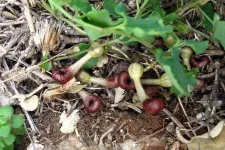
ELSE PRESS RELEASES FROM THIS DATE:
2021-06-10
It eventually became a Nobel prize-winning revolution when researchers first engineered CRISPR as a gene editing technology for bacterial, plant, animal and human cells. The potential of the technology is great and span from curing genetically disposed diseases to applications in agricultural and industrial biotechnology, but there are challenges.
One such challenge consists of selecting a so-called gRNA molecule which should be designed to guide the Cas9 protein to the right location in the DNA where it will make a cut in relation to the gene editing.
"Typically, there are multiple possible gRNAs and they are not all equally efficient. Therefore, ...
2021-06-10
Using a new 3D printing process, University of Nottingham researchers have discovered how to tailor-make artificial body parts and other medical devices with built-in functionality that offers better shape and durability, while cutting the risk of bacterial infection at the same time.
Study lead, Dr Yinfeng He, from the Centre for Additive Manufacturing, said: "Most mass-produced medical devices fail to completely meet the unique and complex needs of their users. Similarly, single-material 3D printing methods have design limitations that cannot produce a bespoke device with multiple biological or mechanical functions.
"But for the first time, using a computer-aided, multi-material ...
2021-06-10
RUDN and Shahid Beheshti University(SBU) chemist proposed an eco-friendly method for the synthesis of pyrrole and pyrazole derivatives with a wide range of applications in medicine: from antidepressants to anticancer. Moreover, the synthesized compounds possess interesting fluorescence features, and the bioactive scaffolds might attract great interest in the fields of clinical diagnostics and biomedical research in the future. The results are published in the Organic & Biomolecular Chemistry.
Heterocyclic compounds expose remarkable chemistry with significant applications in medicinal and organic chemistry, industry, and pharmaceutical. These compounds are widely ...
2021-06-10
Wine grape growers in California and elsewhere face increasing labor costs and severe labor shortages, making it difficult to manage and harvest a vineyard while maintaining profitability. Growers are increasingly turning to machines for pruning, canopy management and harvesting, but how well these practices are executed can substantially affect yield and quality. A new review by researchers at the University of California, Davis, published in the journal Catalyst, provides guidelines for growers to make the best use of machines.
"Wine grape laborers have been virtually nonexistent. People don't want to work in vineyards anymore because it's remote, tough work," said Kaan Kurtural, professor of viticulture and enology and extension ...
2021-06-10
BONN, 10 June - Unprecedented changes in climate and biodiversity, driven by human activities, have combined and increasingly threaten nature, human lives, livelihoods and well-being around the world. Biodiversity loss and climate change are both driven by human economic activities and mutually reinforce each other. Neither will be successfully resolved unless both are tackled together.
This is the message of a workshop report, published today by 50 of the world's leading biodiversity and climate experts.
The peer-reviewed workshop report is the product of a four-day virtual workshop between ...
2021-06-10
Kanazawa, Japan - Fungal diseases in cereal crops cause major economic losses and also threaten human and livestock health, because some fungi produce powerful toxins that might enter the food chain. Farmers use fungicides to control crop diseases, such as wheat head blight. Although agrochemicals are rigorously tested for safety, there can be concerns over chemical residues in food.
Now, researchers at Kanazawa University, in collaboration with colleagues at Ehime University and Nagoya University, have shown that the natural substance nicotinamide (NIM - a vitamin found in food and used as a dietary supplement) can help stimulate ...
2021-06-10
Curtin University researchers have helped uncover the four billion year old story of a lunar sample brought from the Moon to Earth, by the manned Apollo 17 mission more than 50 years ago.
The global research collaboration, involving scientists from the UK, Canada, Sweden and Australia, aimed to analyse the ancient rock sample through a modern lens to find out its age, which crater it came from and its geological trajectory.
That modern lens was provided, in part, by both Curtin's Geoscience Atom Probe Facility* and Space Science and Technology Centre* (SSTC) where the research team was ...
2021-06-10
With the onset of the 4th industrial revolution, artificial intelligence has recently been utilized in smartphone cameras, providing functions such as auto-focusing, face recognition, and 100x zoom, to dramatically improve our daily life. It has also been applied to research and development of new materials.
A joint research team from POSTECH and Korea Institute of Materials Science (KIMS) has applied deep learning to the scanning electron microscopy (SEM) system to develop a technique that can detect and improve the quality of SEM images without human oversight. The EMS is an essential material analysis equipment used for developing new materials. The findings from this research were recently published ...
2021-06-10
An inter-university research group has succeeded in constructing the gene expression network behind the vascular development process in plants. They achieved this by performing bioinformatics analysis using the 'VISUAL' (*1) tissue culture platform, which generates vascular stem cells (*2) from leaf cells. In this network, they also discovered a new BES/BZR transcription factor (*3), BEH3, which regulates vascular stem cells. In addition, they illuminated a novel vascular cell maintenance system whereby BEH3 competes with other transcription factors from the same BES/BZR family in order to stabilize vascular stem ...
2021-06-10
Cell viability require that a variety of functions at the cell membrane are maintained properly. P-type ATPases translocate substrates across the membrane, and they have evolved into different types taking care of specific substrates within a diverse range. Now, key structural aspects have been described on how two different types of P-type ATPases - a Ca2+ transporting Ca2+ -ATPase and a lipid transporting P4-ATPase - have adapted to different substrates and physical environments.
Many bacteria export intracellular calcium using active transporters homologous to the well-described ...
LAST 30 PRESS RELEASES:
[Press-News.org] Botany: Scent of death attracts coffin flies to pipevine flowers

